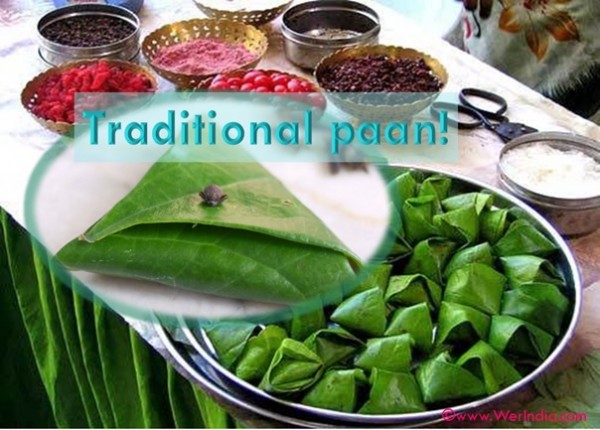
Traditional Paan
Paan leaf and supari together called paan in India and neighboring countries.
Paan lead has several health benefits and supari too. Not only for medicinal purposes, both these have cultural and religious importance in festivals and functions.
In India, one can see paan shops outside restaurants or in markets. There are many varieties of paan leaves and betel nuts.
To prepare paan you need following ingredients:
- Paan(Betel leaves) – 1 or 2,
- Betel nut – pieces – 1 tsp,
- Gulkand – 1 tsp (for sweet paan),
- Mouth fresheners– 1 tsp,
- Sweetened coconut flakes – 1/2 tsp,
- Cardamom powder – 1/2 tsp,
- Glazed cherries – few,
- Chunna (lime) – very little (say a pinch)
How to prepare paan? Wash and dry paan leaf using a paper towel. Remove midrib and stalk of paan. Spread little slaked lime (if you prefer) and roll one edges to form a cone shape or spread the leaf on counter top. Smear chunna on leaf. Inside the cone or on the surface place all ingredients one by one. Close the cone or fold the leaf. Eat this sweet paan after meal. If you don’t want sweet, then don’t add gulkand. How much to consume ? Generally one. If you love it you may eat two.
Health benefits are:
- Digestion improvement: Chewing paan helps in easy digestion. It promotes secretion of saliva which is needed for digestion
- Removes bad breath & odor: Helps to reduce bacterial effect on breath and mouth cavity
- Aphrodisiac: It is known for aphrodisiac effect on humans!
- Anti-diabetic: Paan without sweet is preferred for diabetes. It reduces blood sugar level
Stomach pain relief: Indigestion related stomach pain can be reduced by chewing paan and it also cures constipation.
Author: Sumana Rao | Posted on: January 31, 2018






















Write a comment